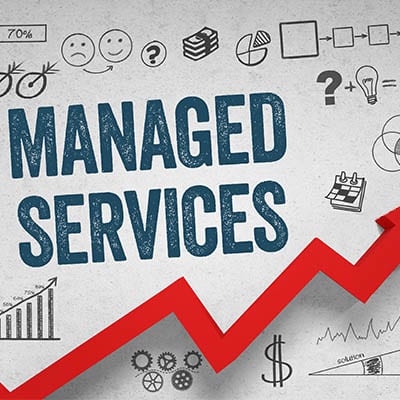Our Industry Experience Managed services technicians aren’t your average computer repair guys. We have to find solutions for so many different situations and problems that our perspective about how to best help an organization shifts. It’s for this reason that an MSP is a wonderful partner in which to build onto your current IT infrastructure. Having an IT support team with plenty of experience isn’t enough. You need to make sure that your IT support options have the experience with the information technology needs of your particular business. Having a support team that understands the demands of–and on–your business can go a long way toward gaining the IT service partner that will be a truly indispensable resource for your company. Response Times One reason that some businesses clutch to the notion that they need to have onsite IT technicians is that they don’t believe the response time of the managed service provider is fast enough to warrant a change. What the decision makers at those organizations don’t quite understand is that MSPs are typically confronting every issue before the onsite IT team is alerted. One of the main benefits of managed IT services is that since we proactively monitor and manage covered endpoints, it saves technicians from having to worry about response time. Couple that fact with the fact that we offer a 24/7/365 help desk that can troubleshoot problems any time of day, you’ll find that with the right MSP, your IT runs better, making your business run better. Scope of Service One of the biggest points of contention businesses have with their IT is that it costs too much to implement. With managed IT services, your business’ whole IT infrastructure is completely monitored and maintained, leaving any IT projects you want deployed real options. Do you want to upgrade your communications? Would you like to put in an IT-based system to be able to manage a part of your business better? Need to meet a new set of compliance standards within the next quarter? You are open to do it. Best yet, even if you have your IT completely managed by SRS Networks, we also provide access to professional IT consultants that not only have great relationships with some of the best vendors in the industry, but have the know-how and determination to help you get your project implemented and working properly. The expanse of expertise you get with an MSP is one of the best benefits of using a managed IT services provider. Cut Costs If you were to staff an IT department with all the tools, experienced technicians, comprehensive consultants, and technical skills that we have, it would cost you a fortune. Outsourcing some or all of your IT responsibilities to a managed services provider not only gives you access to some of the best technical minds in California, it does so at a fraction of the cost than it would if you were to do it yourself. The value you’ll see in the first six months with SRS Networks will make you wonder why you waited until now to call us. If you would like to get comprehensive IT management for a fraction of the price that you are paying now, consider calling us at (831) 758-3636. Our consultants can talk to you about doing […]
If you are currently still using Windows 7, it isn’t as though you won’t be able to use your computer after the January 14. Rather, you will no longer be able to do so securely. The device in question would no longer be receiving the kind of updates and support necessary to protect it from developing threats, and its functionality could degrade as a result. You could also potentially put the safety of your network at risk, if such a device is attached to it. Granted, there are ways that you might still be able to use devices running out-of-support software (like Windows 7) after the official date passes – especially if you need a particular solution to continue a certain business function. You could simply isolate the machines running the susceptible software from the rest of your network, but you still run the risk of these systems being taken offline through some unpatched vulnerability. Your best option is to have a plan in place to retire these solutions and continue your operations in some other way. How You Might Do That There are several options you might consider: Bite the Bullet and Upgrade to Windows 10 Honestly, this is probably your simplest route to take. Windows 7 and Windows 10 have similar operating requirements. In fact, Windows 10 relies on surprisingly little to function: Processor – 1 GHZ or faster RAM – 1 GB for 32-bit or 2 GB for 64-bit Hard disk space – 16 GB for 32-bit or 20 GB for 64-bit Graphics card – DirectX 9 or later with WDDM 1.0 driver Display – 800 x 600 resolution Take note – we said function, not perform. A computer with these specs running Windows 10 simply isn’t going to be very fast, so it makes sense to do more than we’ve listed here. Try using a 2 GHz dual-core processor, installing between 4 and 8 GBs of RAM, and upping the hard drive to 160 GB. Replace Your Hardware To be honest, while this is your easiest option, it is effectively guaranteed to be the most expensive as well… but with so little time left, it may be your best option to keep yourself secure. New hardware will come with Windows 10 installed and will receive regular updates – the only downside is it may take some time to configure. Use ChromeOS Many businesses are considering the tasks that their employees are responsible for and opting to provide them with Chromebooks rather than Windows workstations. While the cost-effectiveness of this approach can’t be argued, there are other issues to consider. Any line-of-business application would need to be virtualized, and Internet access is a prerequisite to using a Chromebook. While this may be a budget-friendly option on the surface, these hidden costs could cause a rise in your overhead. Use a Thin Client Via Virtualization In some ways similar to using the Chromebook option, you could simply repurpose your old hardware to host virtualized thin clients to accomplish what needs to be done. Of course, with the looming deadline, this may also be a challenge to pull off. However, Microsoft will still offer the option to use a service called Microsoft 365, which combines Windows 10, Office 365, and a terabyte of OneDrive storage along with the security […]
Now, to literally become more organized, you’ll need to better manage your documents, keeping your workspace clean (and, of course, motivating your crew to do the same). On the abstract side, we’re describing all of the digital storage and tools that can help you keep your business on track. Let’s dive in, starting with the literal. Managing Your Documents While paperless offices are increasing in popularity, you may have business-related reasons to continue keeping paper copies of things, along with other kinds of documents that are generated as hard copies by their nature. This includes things like handouts, business cards, and quickly-jotted-down notes. This situation makes a document management system a worthwhile investment, so that once you’ve sorted through your collected documents, you can move forward with a better option for organizing them. Cloud solutions are a good place to store digital files, as they allow controlled collaboration with those who need access to certain files and resources. You may also want to reconsider if a paperless system would work for you. Many of the reasons that hardcopies were once necessary are now able to be attended to digitally – like collecting signatures, organizing receipts, even retaining business cards. Working in the Right Space While we’re working on reducing the paper clutter in the office, keep in mind that an organized workspace can provide significant boosts to productivity. Encourage your users to minimize distractions on their desk – but don’t ban any personalization, either, unless it would be inappropriate for other reasons. While organization is easier with less to occupy a given space, some level of personalization can help an employee stay engaged, and less like they are in a bubble. In order to better organize a workspace, encourage your employees to manage things as they go, rather than letting items or documents stack up in a “to-do” pile. Each thing on their desk should also have a set place to be, allowing them to more quickly find what it is that they need – contributing to fewer impacts upon their focus. Use Various Business Organization Tools There are many different solutions that, as we briefly referenced above, can help you to digitize and organize your assorted resources and files. These include: Contact Management – Rather than the antiquated Rolodex or address book, there are software titles that make it simpler to manage your contacts. A comprehensive customer relationship management solution can fulfill this need, as well as many others. Accounting and Bookkeeping – A business’ cash flow is critical to its success, and the more organized it is, the less likely it is that mistakes will be made. With options to assist your invoicing, payment acceptance, and cash flow management, we can help you here. Communication – A big part of organization is the ability to communicate with the rest of your team regarding where different things are, as well as their status. From email platforms, instant messaging solutions, and project management solutions, there are various means of encouraging this kind of communication. Organizing your business can be much simpler than it sounds, especially with SRS Networks helping you. Reach out to us at (831) 758-3636 for more!
Why Is Everyone Swiping? When payday comes once a week or once every two weeks, how do you receive your paycheck? More than half of the US utilizes and relies on direct deposit. It’s no wonder cash has become a scarce payment method. Convenience is such a powerful underlying reason to ditch cash payment. What are the pros, and what are the cons to this convenience? Let’s first talk about some of the pros. Security! Surely, not carrying a wad of cash in your pocket is a more secure method, right? Well, that depends on the type of card you’re carrying as well as the coverage the lender has agreed to. If you have ever hidden something of value from yourself such as your license, cash, your wallet, or even car keys, then you know how it feels to be worried about your belongings. If you’ve ever fully lost one of these objects, you’re not the only one. So how would you proceed if you lost a few hundred dollars cash that was in your wallet? Well, this is where you discover the fact that a credit card is typically a superior payment method. Borrow protection has become a standard in most lender scenarios. Most banks are FDIC (Federal Deposit Insurance Corporation) covered. Yes, in 1933 and even sometimes today, people had a hard time trusting banks with their money. These mattress-stuffers have failed to realize that in nearly every case your money is actually covered by insurance. With a credit or debit card, that few hundred dollars you lost would never actually leave the comfort of your bank account. If some sort of fraudulent activity occurs where money actually disappears from your account for an unauthorized reason, lenders today are able to refund you while disabling the existing card, preventing recurring theft. How Else are Cards Protected? Credit and debit card utilization has caused strict standards of security to be implemented anywhere that accepts these forms of payment. These standards are referred to as the Payment Card Index Digital Security Standard, or PCI DSS. This mandates all businesses to protect data collected about the cardholder. This includes any and all information found on the user’s card. This information should NOT be stored, unless recurring billing or some other product or service improvement has been negotiated with the cardholder. Here are some other protection methods which further prove the benefit to leaving cash at the bank: Dynamic Card Verification Values – Your CVV value is what can prevent someone from taking a picture of your credit card as you pull it out of your wallet from actually being able to make purchases with it. This value on the back of most payment cards adds that extra layer of security that could foil a determined thief. As technology changes, even these CVV often feel the effects. Today, some lenders provide cards that utilize a different value for each time of day. Mobile Wallet – While most of us have seen commercials of someone paying for goods or a service simply by holding their smartphone up to the reader, this technology has evolved into far more than a gimmick. This method of payment, if handled properly, can be an extremely convenient and secure means to purchase things. Biometrics – Biometric technology has […]
What Are Browser Extensions? Essentially, browser extensions are pieces of software that bring external integrations to the functionality of the browser itself. In Chrome and Microsoft Edge, they are called extensions, while in Firefox they are called add-ons. There are all types of options to choose from. There are apps to help with browser security, productivity, communications, and much more. A problem that many users–business and otherwise–have with these browser extensions is that sometimes they can be vulnerable to infiltration (or they just flat-out spy on you). This presents a situation where, sure you are getting some enhanced productivity, but if the price is that you need to put your data at risk, that boost in productivity won’t help. Obviously, some browser extensions/add-ons are secure and have major utility for end-users. Ad blockers, screenshot tools, password managers, and instant messaging tools are often deployed through extensions by users to improve the functionality and security of their browsing experience. Examples of Risks People have been using these browser extensions for some time. Just this last year, millions of users of Google Chrome, Mozilla Firefox, and Chromium-based browsers such as Opera were victims of rogue extensions/add-ons. These extensions collected people’s data through capturing titles and URLs of the websites they clicked on. This unauthorized data collection included sensitive data such as medical records and credit card information. Then, if that wasn’t bad enough, the collected web histories of these users were published by a paid service called Nacho Analytics. Google Is Stepping Up Soon after the news broke, Google went ahead and set a policy that is aimed at improving the security of the extensions available on the Chrome Web Store. They launched a full-scale audit of the system, which they called Project Strobe. The findings of this audit led them to change the policy of third-party extensions. Now extensions will only be able to request access to the minimum amount of user data necessary to function. The company also announced they will extend the requirements around its privacy policies. The new changes will be implemented throughout the end of 2019 and into 2020. There are currently 180,000 extensions available on the Chrome Web Store. Essentially, the shift is going to make it more difficult for these third-party extensions to grab user information. Data security has to be a major point of emphasis for any business or organization that relies on information systems to function effectively. Call the IT experts at SRS Networks today at (831) 758-3636 to learn more.
Colleen from finance had handed out treats, Fresh homemade cookies, hand-frosted and sweet, So, with smiling mouths filled with sugary tastes, All had made their way home, arriving with haste. With Santa Claus starting his gift-giving flight, The office was dark, with minimal light. The monitors sleeping, the servers were quiet, All was at peace, no cause for disquiet. For the office was shielded by a steadfast guard, A managed service provider, of highest regard – And thank goodness it was, for early that day An emergency threatened to cause a delay. In early morning hours, December 24, The servers were running their nightly backup chores. The MSP realized the problem at hand, Their disk space was filled up, an issue unplanned. Luckily, the office had wisely signed on, To have their IT watched over to avoid denouement, Remote Monitoring and Maintenance protected their assets, As the MSP caught and resolved any threats. From malware and spyware, to issues of all kinds, Attacks and vulnerabilities, and all of their signs, The MSP acts, and the MSP delivers, Acting as a business’ IT caregivers. So, when the MSP realized the disk space-based issue, A solution was deployed so the backup could continue, By deleting some outdated backups to free up space, The MSP reported the problem to the workplace. But the MSP did more than just issue a report, The professionals there explained why the backup fell short, And recommending to the business more space to save data, The MSP helped keep their storage pro rata. How happy the business was to have this service – To know that they had little reason to be nervous! To trust that any problems of theirs would be addressed, Without breaking the bank or leaving them stressed. So, the staff of the business was free to relax, Without worrying that problems would fall through the cracks. So, without any remnants of their after-hours plight, A Happy Christmas was had by all, and all had a good night.
A VPN provides a useful layer of security when transmitting data. It does this by forming dedicated connections over a Wide Area Network (WAN). This dedicated connection utilizes encryption to protect sensitive data. While doing so doesn’t create an impenetrable security system, it does ensure this sensitive data will be unreadable and useless if a hacker intercepts the data transmission. VPNs can be very useful to all businesses alike. Here are three reasons a VPN is right for you: Cost Effectiveness – A VPN provides a sense of security for what amounts to a minimal investment… a real no-brainer for a business that needs to keep the data it transfers safe. Client Confidence – While many may not consider this when weighing the benefits of a VPN, the confidence you will have in your data security will help impress your clients, both current and potential. An impressed client is more likely to be a loyal client. Proven Productivity – When a VPN is used, the data transferred over it is obscured from unwanted eyes. This means that a VPN can be used to help make an insecure connection safe for your data to be transferred over, allowing your staff the ability to safely work from out of the office, decreasing the impact of absences. Plus, a VPN is very user-friendly, meaning that your least tech-savvy employee can still use it effectively. A VPN is critical to a comprehensive cybersecurity strategy, especially if you operate out of more than one location or have remote workers and data therefore needs to be accessed from more than one area. To learn more about putting a VPN into place, reach out to SRS Networks! Call (831) 758-3636 today.
What Is an Internet Meme? The concept for the meme was actually an academic concept coined by biologist Richard Dawkins in his 1976 book The Selfish Gene. He suggested that it was the evolution of society to create units of cultural transmission. Today, that thesis is carried out millions of times a day through the Internet meme. They are messages shared across the Internet typically using images to represent the underlying feelings, thoughts, and beliefs of the people creating and sharing them. Their prevalence cannot be underestimated, as they have evolved to cover all of human existence (and further). There are three variables that make an Internet meme successful. They are: longevity, fertility, and copy-fidelity. This means that the most popular Internet memes resoundingly resonate with people, creating the need for duplication, and ultimately, replication using similar scenario-specific criteria. Basically, the meme is shared, copied, shared, altered slightly, and shared. With the advent of social media, meme use has exploded, becoming a cultural phenomenon that transcends specific topics. Our Favorite IT Memes You probably already understand why you like memes: they tend to make you laugh because you relate with the perceived message/action. Here are a few of the IT memes we like: Managed IT Services This meme starts from a scene from the movie Taken where retired CIA field agent Bryan Mils had his daughter stolen. In the movie, he utters the phrase, “I have a particular set of skills…” The meme was changed to use that very well-known phrase and image to list his IT management skills. This meme shows the character Andy Dwyer of NBC’s Parks and Recreation who is a simple man with a heart of gold; and, whose naivete and enthusiasm have landed him in an uncomfortable position. In fairness, there are many people who still aren’t sure of what managed services actually are, making this meme relevant. IT Support This meme shows Lt. Commander Montgomery Scott on the Com on the bridge of the U.S.S. Enterprise. The U.S.S. Enterprise is far-and-away a more complicated machine than your average PC (despite the lights and tactile switches found in the shot), the term “Have you tried switching it off and on again?” is funny. It is the first thing that tech support will ask anyone if their device isn’t working properly. Backup and Disaster Recovery Some memes are funnier than others. This one, featuring “disaster girl” suggests that the reason you need disaster recovery is because your sweet, unsuspecting child just might be a demon-seed. Protecting what you have is important, and for the business, that means disaster recovery. The Cloud Cartoons, like the one above, can be memes. In fact there are five potential memes in this cartoon, but we thought we would post the full cartoon because it’s enjoyable. If you were to meme this cartoon successfully, it would look something like this: Sometimes memes get right to the point instead of trying to be cute. This one, with a picture of Morpheus from the popular movie The Matrix tells the ultimate truth about computing in the cloud. The cloud has many computing users confused, but in essence, the cloud is just another computer somewhere on the Internet in which you store your data, run applications from, etc. Cybersecurity Cybersecurity is one of the most […]
What Not to Do There’s a tricky balance to strike when devising a password. On the one hand, you want it to be sufficiently secure, but on the other, you don’t want to make it too difficult to get back in for yourself, either. This is probably the reason that so many password rules and best practices are broken and ignored: user convenience. Let’s take a look at the top 15 results of some data compiled by the United Kingdom’s National Cyber Security Centre with the help of the security website Have I Been Pwned, regarding the most commonly breached passwords: 123456 123456789 qwerty password 1111111 12345678 abc123 1234567 Password1 12345 1234567890 123123 000000 Iloveyou 1234 Just glancing over this list, you can very easily see how a few of the simplest password quality rules are broken – common words, common number strands, and hardly any mix of alphanumeric characters. It is probably also a safe bet that a person who would use a password like this would also be the person to repeat their password across accounts. This means that if one of their accounts were breached, they all would be rendered insecure. Of course, now that we’ve clearly outlined the problem, we have a proposed strategy to help fix it. Using a Truly Random Passphrase One way that you can improve upon password security is known as the passphrase. Instead of using random characters, random words are used, helping to make it both more complicated and easier to remember. The web comic xkcd does a good job of explaining it: However, this opens us up to new issues – like the very human instinct to stick to a pattern of some sort. Good for survival, not so great when you’re looking for true randomness. This is why an IT professional named Arnold Reinhold developed a new method of generating a passphrase, called Diceware. Taking a die, roll it five times, taking note of the numbers you’ve rolled. Whatever the 5-digit number you produced was, find it on the official Diceware word list. That is now the first word of your passphrase. Repeat this process until you have six or seven words in your passphrase. This helps eliminate human bias from the selection process, making this process about as random as possible. Demonstrating Diceware in Action Rolling a die, I came up with 45656. Diceware says that’s “pleat.” My next roll came up 13211. “Bach.” 34663, making the next word “Julie.” 32135 means the next word is “gulp.” 32565, for a final word “choice” of “Hera.” So, my new passphrase is “pleatBachJuliegulpHera.” Gibberish, yet still far more memorable than the alternative system. Remembering All These Passphrases So, with the “random” part of our concerns addressed, there is still the concern that remembering so many different passphrases may be a bit much to ask. This is why we recommend that you combine your use of passphrases with the use of a password manager. These handy programs secure all of your passwords (or passphrases) in a secure vault, ready for you to access with a single, master password (or passphrase). As a result, as long as you can remember one passphrase, you can use the password manager to handle the rest of your accounts. For help in implementing all of this […]
How Many Devices Are On This Network? When your business was first put together and you initially started out, you could very well have been using technology in one way, and it could have been very different than what you are doing now. This means that the infrastructure that was first put into place may not have allocated resources appropriate for what you are trying to accomplish. Ignore what you needed in the past – what do you need now? How many users need to connect to the network… and how many devices will that equate to? Many devices now connect to the Internet to function, and how many devices are involved with your business that also connect to its Wi-Fi, like point-of-sale systems or wireless printers? You may be overtaxing your wireless network. One easy fix is to hardwire the things that can be, freeing up the wireless. What Processes Need to Be Supported? What is it that you need your wireless network to do, exactly? Based on these needs, you may need to adjust your business’ infrastructure to match – down to the kind of router you’re using. Different models of routers offer different features. Our IT experts are here to make sure you get the appropriate equipment for your particular situation – the first time. How Secure is Your Internet? As critical as the Internet is for many businesses to be able to operate, it is also a great tool for many criminals trying to take advantage of these businesses. Using networking equipment that helps to prevent these kinds of issues with built-in protections like firewalls and antivirus certainly helps. The professionals here at SRS Networks are ready to help you determine exactly what your business needs. To learn more, reach out to us at (831) 758-3636.










